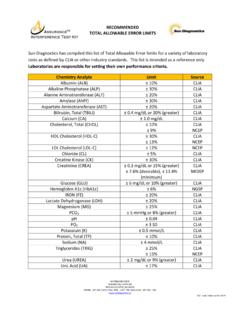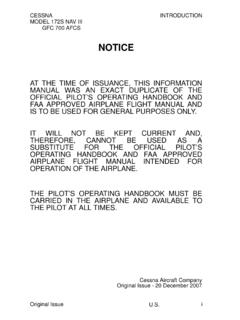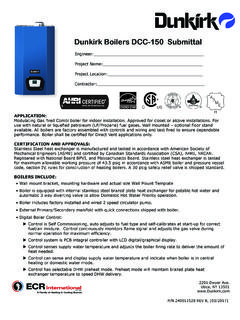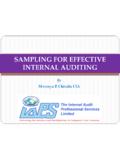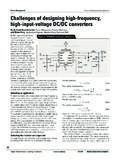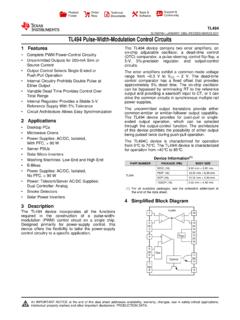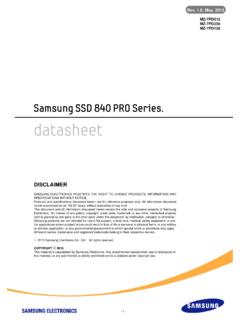Transcription of Chapter 5 - FIELD WORK AND SAMPLING
1 Water Quality Monitoring - A Practical Guide to the Design and Implementation of Freshwater Quality Studies and Monitoring Programmes Edited by Jamie Bartram and Richard Ballance Published on behalf of United Nations Environment Programme and the World Health Organization 1996 UNEP/WHO ISBN 0 419 22320 7 (Hbk) 0 419 21730 4 (Pbk) Chapter 5 - FIELD work AND SAMPLING This Chapter was prepared by J. Bartram, A. M kel and E. M lkki The FIELD work associated with the collection and transport of samples will account for a substantial proportion of the total cost of a monitoring programme. SAMPLING expeditions should, therefore, be planned and carried out in such a way that efforts are not wasted. If, for example, an essential piece of equipment is forgotten or an inadequately described SAMPLING station cannot be found, the value of that particular SAMPLING expedition is seriously compromised. Similarly, if unrealistic estimates of travel time are made and an expedition takes longer than intended, samples may be held longer than the maximum allowable storage time and the results of analyses will be of questionable value.
2 Special aspects of FIELD work and SAMPLING associated with biological methods and sediment measurements are given in Chapters 11 and 13 and in the companion guidebook Water Quality Assessments. The sample collection process should be co-ordinated with the laboratory so that analysts know how many samples will be arriving, the approximate time of their arrival and the analyses that are to be carried out, and can thus have appropriate quantities of reagent chemicals prepared. It is good practice to prepare a checklist such as the one on the following page, so that nothing is missing or forgotten before a SAMPLING expedition is undertaken. Many of the items in the list are self-explanatory; others are described more fully in later sections of this Chapter . Personnel who will collect water, biota or sediment samples must be fully trained in both SAMPLING techniques and FIELD test procedures. They should also be aware of the objectives of the monitoring programme since these will have some influence on the SAMPLING procedures.
3 Obtaining a sample that is fully representative of the whole water body is difficult and the collection and handling of samples are also frequent sources of error (often greater errors than those arising during analysis). Thus the choice of a representative SAMPLING point and the use of appropriate SAMPLING techniques are of fundamental importance (see Chapter 3 and the companion guidebook Water Quality Assessments). Checklist for preparing for FIELD work Paperwork Itinerary Inventory details of SAMPLING stations; maps List of samples required at each SAMPLING station List of stations where water level readings are to be recorded (see Chapter 12) Co-ordination Local co-ordination, for example, to ensure access to sites on restricted or private land Institutional co-ordination, for example, for travel arrangements or sample transport Notify laboratories of expected date and time of sample arrival Check any available sources of information on local weather conditions and feasibility of travel For SAMPLING Sample bottles, preservatives, labels and marker pens Sample storage/transit containers and ice packs Filtering apparatus (if required) Samplers/ SAMPLING equipment Rubber boots, waders, etc.
4 Standard operating procedures for SAMPLING Spares of all above items if possible and when appropriate For documentation Pens/wax crayons Sample labels FIELD notebook Report forms For on-site testing List of analyses to be performed on site Check stocks of consumables (including distilled water, pH buffers, standards and blanks); replenish and refresh as appropriate Check and calibrate meters (pH, conductivity, dissolved oxygen, turbidity, thermometers) Other testing equipment according to local practice Standard operating procedures and equipment manuals Spares ( batteries) Safety First-aid kit Waders, gloves, etc. Fire extinguisher (if appropriate) Transport Does assigned vehicle have sufficient capacity for personnel, supplies and equipment? Is vehicle road-worthy? Check battery, lubrication, coolant, windshield washer Is there sufficient fuel for the trip, either in the tank, in fuel cans, or available en route?
5 Is the spare tyre inflated, is there a jack, wheel wrench and tool kit? Double-check When was equipment last calibrated? Itinerary against travel details on inventory Accessories for equipment and meters (including cables, chargers and spare batteries) and consumables Only if samples can be taken consistently from the same locations, can changes in the concentration of water quality variables with time be interpreted with confidence. It is advisable to carry out a pilot programme before the routine monitoring programme begins (see section ). This can be used as a training exercise for new personnel and will provide the opportunity to make a final selection of SAMPLING stations on the basis of whether they are representative of the whole water body as well as readily accessible. Programme managers and laboratory personnel should accompany FIELD personnel on FIELD expeditions from time to time. This provides opportunities for FIELD supervision as part of in-service training and for everyone working on the programme to appreciate the problems and needs of FIELD work .
6 On-site testing is common for certain variables, especially those that may change (physical, chemical or biological) during transport. Dissolved oxygen, turbidity, transparency, conductivity, pH, temperature and, to a lesser extent, thermotolerant (faecal) and total coliform counts are the variables most often measured on site. Procedures for carrying out analyses in the FIELD are covered in Chapters 6 and 10. The special problems of analytical quality control during FIELD testing or testing using portable equipment are outlined in section , and further information on minimising the risks associated with this approach is provided in Chapter 9. Sample containers Containers for the transportation of samples are best provided by the laboratory. This ensures that large enough samples are obtained for the planned analyses and that sample bottles have been properly prepared, including the addition of stabilizing preservatives when necessary.
7 It is essential to have enough containers to hold the samples collected during a SAMPLING expedition. Sample containers should be used only for water samples and never for the storage of chemicals or other liquids. Glass containers are commonly used and are appropriate for samples for many analyses, but plastic containers are preferred for samples intended for certain chemical analyses or for biota or sediments. Plastic has the obvious advantage that it is less likely to break than glass. Sample containers must be scrupulously clean so that they do not contaminate the samples placed in them. Table provides general information on appropriate types of sample container and the recommended procedures for cleaning them when water samples are to be used for chemical analysis. For microbiological analysis, strong, thick-walled, glass sample bottles with a minimum capacity of 300 ml should be used. They should have screw caps of a type that will maintain an effective seal, even after they have been sterilised many times in an autoclave.
8 Some technicians fasten a Kraft paper cover over the bottle caps before autoclaving to protect them from contamination during handling. Alternatively, plastic or aluminium sleeves may be used. The neck of the bottle should not be plugged with cotton wool. To prepare sample bottles, they should be washed with a non-ionic detergent and rinsed at least three times (five is better) with distilled or deionised water before autoclaving. New bottles require the same preparation. If distilled or deionised water is not available, clean chlorine-free water may be used. If chlorinated water is being collected for microbiological analysis, sufficient sodium thiosulphate should be added to the sample bottles to neutralise the chlorine. The recommended amount is ml of a per cent solution of sodium thiosulphate for each 100 ml of sample bottle volume; this should be added to the bottles before autoclaving. Sample bottles should not be rinsed with sample water or allowed to overflow because this would remove the dechlorinating chemical.
9 Table Sample containers and their recommended washing procedures for selected water quality variables Variable(s) to be analysed Recommended container1 Washing procedure Organochlorinated pesticides and PCBs Organophosphorus 1,000 ml glass (amber) with teflon-lined cap Rinse three times with tap water, once with chromic acid2, three times with organic-free water, twice with washing acetone, once with special grade3 acetone, twice with pesticide grade hexane and dry (uncapped) in a hot air oven at 360 C Pentachlorophenol Phenolics Phenoxy acid herbicides 1,000 ml glass (amber) with teflon-lined cap Rinse three times with tap water, once with chromic acid2, three times with organic-free water, twice with washing acetone, once with special grade3 acetone, twice with pesticide grade hexane and dry (uncapped) in a hot air oven at 360 C for at least 1 h Aluminium, Antimony, Barium, Beryllium, Cadmium, Chromium4, Cobalt, Copper, Iron, Lead, Lithium, Manganese, Molybdenum, Nickel, Selenium, Strontium, Vanadium, Zinc 500-1,000 ml polyethylene (depending upon number of metals to be determined) Rinse three times with tap water, once with chromic acid2, three times with tap water, once with 1:1 nitric acid and then three times with ultrapure distilled water5 in that order Silver 250 ml polyethylene (amber) Rinse three times with tap water, once with chromic acid2, three times with tap water, once with 1:1 nitric acid and then three times with ultrapure distilled water5 in that order Mercury 100 ml glass (Sovirel) Rinse three times with tap water, once with chromic acid2, three times with tap water, once with 1.
10 1 nitric acid and then three times with ultrapure distilled water5 in that order Acidity, Alkalinity, Arsenic, Calcium, Chloride, Colour, Fluoride, Hardness, Magnesium, Non- filterable residue, pH, Potassium, Sodium, Specific conductance, Sulphate, Turbidity 1,000 ml polyethylene Rinse three times with tap water, once with chromic acid2, three times with tap water, once with 1:1 nitric acid and then three times with distilled water in that order Carbon, total organic Nitrogen: ammonia Nitrogen: nitrate, nitrite Nitrogen: total 250 ml polyethylene Rinse three times with tap water, once with chromic acid2, three times with tap water, and three times with distilled water, in that order Phosphorus, total 50 ml glass (Sovirel) Rinse three times with tap water, once with chromic acid2, three times with tap water, and three times with distilled water, in that order 1 Teflon containers can also be used to replace either the recommended polyethylene or glass containers 2 Chromic acid - 35 ml saturated Na2Cr2O7 per litre reagent grade conc.










